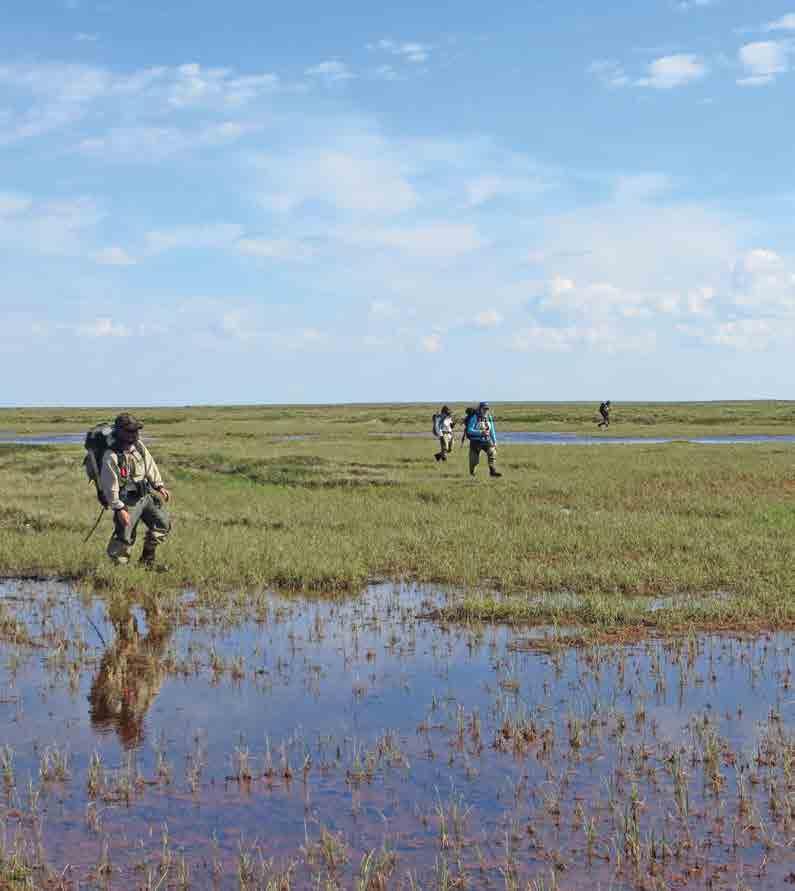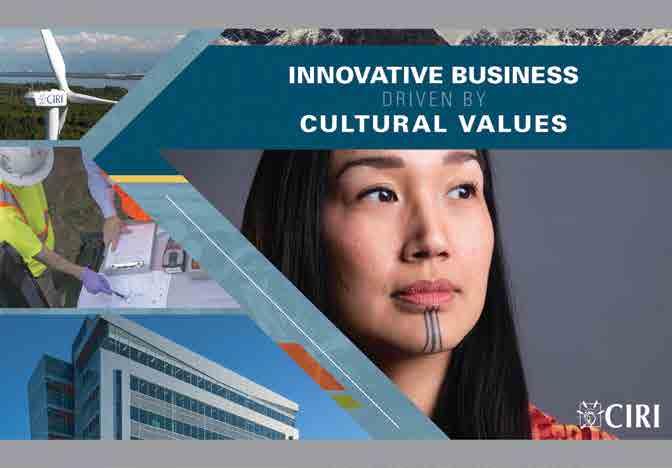
10 minute read
ENVIRONMENTAL
Abundant Environmental Fields
The multi-faceted job opportunities in environmental services
By Amy Newman
Acareer in environmental services tends to evoke clichéd images of eco-warriors protesting the cutting of timber or oil extraction, but scratch the surface and it becomes clear that the field is far from that stereotype.
“[Environmental science] means a lot of different things to a lot of different people,” explains Adrian Gall, president at ABR, Inc., an environmental consulting firm with offices in Anchorage and Fairbanks. “It can mean permit compliance and writing permit acquisition, or it can be more grounded in the environmental and physical sciences, where you want to go out and answer very applied questions.”
The environmental services industry is an umbrella term that encompasses a variety of subspecialties and positions, from studying wildlife habitats to creating spill prevention mitigation strategies, from coordinating environmental clean-up to preparing environmental impact statements. And it crosses into every industry that could impact the environment.
“There are so many things you can do,” says Dan McMahon, environmental group leader at Shannon & Wilson’s Anchorage office. “Even just doing mostly site assessment and cleanup, there are so many facets to it.”
Regardless of the enormity and variety within the field, the common thread throughout the work is the interplay between the environment and the people and industries who interact with it.
“The thing that draws it all together is this interface between the built and the natural world,” Gall says. “That’s where environmental sciences operate, in that space where people interact with everything else around them and affect the natural world, in one way or another. And you have to have an interest in that, in operating in that interface of people and the rest of the ecosystem.”
One Industry, Many Fields
In Alaska, the environmental services industry is most frequently thought of as a safeguard—making sure oil and gas and mining activities aren’t disturbing the surrounding habitat during extraction and development work. In reality, it extends far beyond that, reaching into any industry, including timber, transportation, telecommunications, and even real estate, that directly or indirectly impacts the environment.
“We have these laws and regulations in place to help maintain ecosystems,” Gall says. “As we carry out these development projects—whether that’s drilling for oil or mining or timber— whatever these extractions are, we have to ensure things are done in a way that doesn’t completely destroy where we live.”
Some large organizations have in-house environmental teams, but most companies hire environmental consulting firms to help with specific “[Environmental science] means a lot of different things to a lot of different people. It can mean permit compliance and writing permit acquisition, or it can be more grounded in the environmental and physical sciences, where you want to go out and answer very applied questions.”
Adrian Gall, President, ABR, Inc.
projects, whether that’s collecting and analyzing data or assisting with spill clean-up. Even large companies that have an environmental team on staff will often turn to outside consultants for help with certain projects, particularly one-time jobs like creating an environmental impact statement.
“Part of it is just the specialized knowledge that the consultants have,” says Eran Hood, professor of environmental science at the University of Alaska Southeast. “The people who are developing those projects typically don’t have the skills to do those inhouse, so they will contract with environmental consultants to complete that piece of it.”
There’s also a public sector side to the environmental services industry. Where the private sector is concerned with obtaining permits, preparing environmental impact statements, collecting and analyzing data, and ensuring compliance with local, state, and federal regulations, their public sector counterparts act as the gatekeepers, making sure that every step of the process is completed in accordance with those regulations.
“On the government side of it, there’s a lot of regulatory work and managing the resources, either from the state or federal perspective,” Hood explains. “And then if you go on to the industrial side, they have the obligations that are being dictated to them by the state and federal groups; that you need to do this kind of monitoring at your mine [or] collect these kinds of measurements.”
That means private sector consultants act as a bridge between their clients and their public sector counterparts, which can sometimes create confusion about whose interests the consultant is promoting.
“We’re not an agent of the state; we’re working for our clients,” McMahon explains. “It’s not how I want to clean it up, it’s how the state wants it cleaned up. I know how to help our clients satisfy state regulations, and that’s a lot of what the job is, helping our clients understand the regulations and being the go-between the regulator and our client.”
For those who aren’t drawn to either the public or private sector, there’s always the nonprofit or academic worlds.
“We have a lot of students who go on to work in nonprofits,” Hood says. “There’s a big watershed coalition down here, there’s a fish habitat partnership that’s a nonprofit, so we’ve had students who are interested in environmental management go on to work with those types of groups as well.”
A Scientific Background
A bachelor’s degree with a science focus is considered the minimum requirement for a career in environmental services, though which degree depends on the individual’s specific area of interest.
“The field wasn’t as developed as it was when I started twenty-five years ago,

“If you want to go more into the research end of things, doing fieldwork, you’d want an ecological science background. If you’re more into the permitting end of things and collecting the information and then trying to get permits for particular projects and ensure compliance with the regulations, then a more general background in environmental science is certainly a good degree.”
Adrian Gall, President, ABR, Inc.
but honestly, I’d get an environmental science or environmental engineering degree,” McMahon says. “I do a lot of hiring and I usually look for engineers and environmental scientists, geologists, or chemists.”
Gall agrees.
“If you want to go more into the research end of things, doing fieldwork, you’d want an ecological science background,” she says. “If you’re more
into the permitting end of things and collecting the information and then trying to get permits for particular projects and ensure compliance with the regulations, then a more general background in environmental science is certainly a good degree.”
The undergraduate degree provides a solid foundation in the basics, with marketable skills acquired through a combination of coursework and internships, Hood says. But like many other professions, much of the learning is done on-the-job.
“I think almost all of it [is] learned on the job,” McMahon says. “You have to learn how the regulations work; you have to learn how the real world works. There are very few things here I think people learned in science.”
Though an advanced degree isn’t required, those with an interest in management positions typically obtain one at some point.
“When you do a master’s in any one of the ecological disciplines, you get experience doing study design, developing statistical skills, and other things that are kind of required to make those determinations about impact, so more quantifiable skills,” Gall explains. “But you can go really far with a bachelor’s degree; you can have a great career going no further.”
Certain disciplines also have advanced certifications, such as a certified wildlife scientist, professional wetland scientist, or hazardous waste certifications, common for those dealing with environmental cleanups, Hood says, but those are generally obtained later while on the job.
Changing Tools of the Trade
Technological advances have changed the way the industry operates, but McMahon says those changes don’t necessarily make the work easier; rather, they simply add a different dimension to how it’s done.
“When I started, it was Microsoft Word and Excel,” McMahon says. “Now they have so much knowledge and the technologies have come so far. Everybody here either knows AutoCAD or GIS. There’s all this stuff in people’s toolboxes that wasn’t there before.”
Geographic information systems (GIS), GPS, and drones are just some www.akbizmag.com
We ship anywhere
USE WASTE OIL TO in Alaska HEAT YOUR FACILITY!

ENERGY SYSTEMS The World Leader in Used-Oil Heating Systems
– Burns waste oil – Generates more heat – Long service life
We are the exclusive distributor for Clean Burn waste oil heating equipment in Alaska. We carry a full range of Clean Burn Genuine OEM parts and o er sales, installation help, unit cleaning and return services.
Nenana Heating Services, Inc.
PO Box 9 • Nenana, AK 99760 (907) 832-5445 or (800) 478-5447 E-mail: NHSI@alaska.net cleanburn.com/nenana-heating

of the technologies that have changed how, and how much, data can be acquired and analyzed.
“Certainly, using a lot of GPS in the way surveying is being done now is very different,” Hood says. “On the GIS side, I would say everyone uses GIS—the city uses it, the state uses it, if you look at all the COVID dashboards or companies that are developing any type of project, you have to have GIS information.”
Drones can capture video and still images from hard-to-reach locations, while new software makes it possible to stitch together the hundreds of photos they capture to create digital topographic maps based on the drone’s GPS position, Hood says.
“You have the ability to map relatively large areas with a drone in a way that wasn’t possible just a few years ago,” he says. “Previously, you had to hire surveyors and use airplanes to do these kinds of things.”
The sheer amount of data that can now be collected means possessing the ability to visualize and archive such large streams is increasingly important.
“So many environmental sensors now can collect data every ten seconds for a year, so people are putting sensors in rivers and [using them] to look at wind,” Hood says. “So to have the ability to work with the large data streams that those are creating is another really valuable skill.”
Technological advancements also increase the safety of field workers.
“With aerial surveying, it’s a risk to put people in planes, so there’s a big move to do [these things] with video or cameras,” Gall says.
A Data Mindset
Notwithstanding educational requirements, industry roles require a keen interest in performing the type of work called for by the position.
“If you’re doing something that’s very GIS- or very data-oriented, you’re going to be someone who enjoys spending time in front of a computer and spending time on those applications,” Hood says. “In contrast to that, some of the jobs are extremely field-oriented, and so if you’re going to work on collecting all the baseline data, you’re going to be out flying in helicopters, working on weather stations, and to some people, that’s a huge draw for sure.”
For people working in the field, being able to think outside the box is hugely beneficial.
“It’s really good if you have the kind of mind that can take on new tasks and try new things and figure out things on your own, that kind of jack-of-all-trades mentality,” McMahon says.
Those working in the industry should also have an interest in the environment, though exactly what that looks like can vary greatly.
“I think there needs to be a passion for what we’re doing and hopefully an understanding of the importance of maintaining the ecological integrity [as] human beings move through these worlds,” Gall says. “And maybe that is my ideal. For some people, their priority is figuring out how to comply with the letter of the law.”
Whether the work is in the public, private, or nonprofit sectors or performed in the field or behind a desk, McMahon says variety is what makes the job fulfilling.
“It’s hard to be bored because there’s always something new,” McMahon says. “It’s great to have that, to think you can always do something new.”










